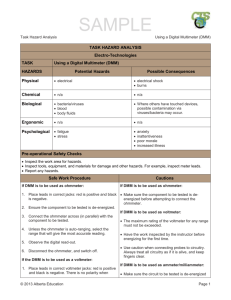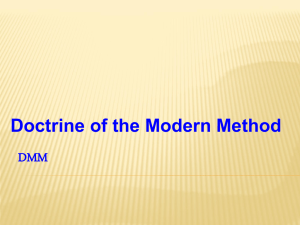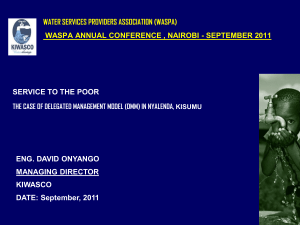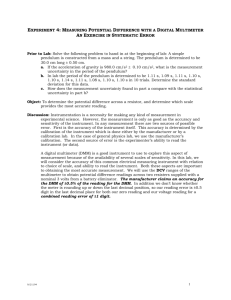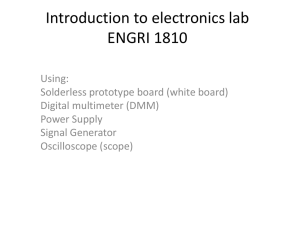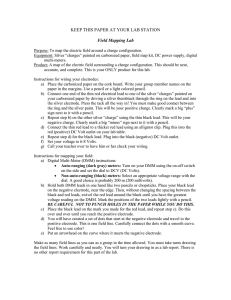An Integrated Dynamic Market Mechanism for Real-time Markets and Frequency Regulation
advertisement
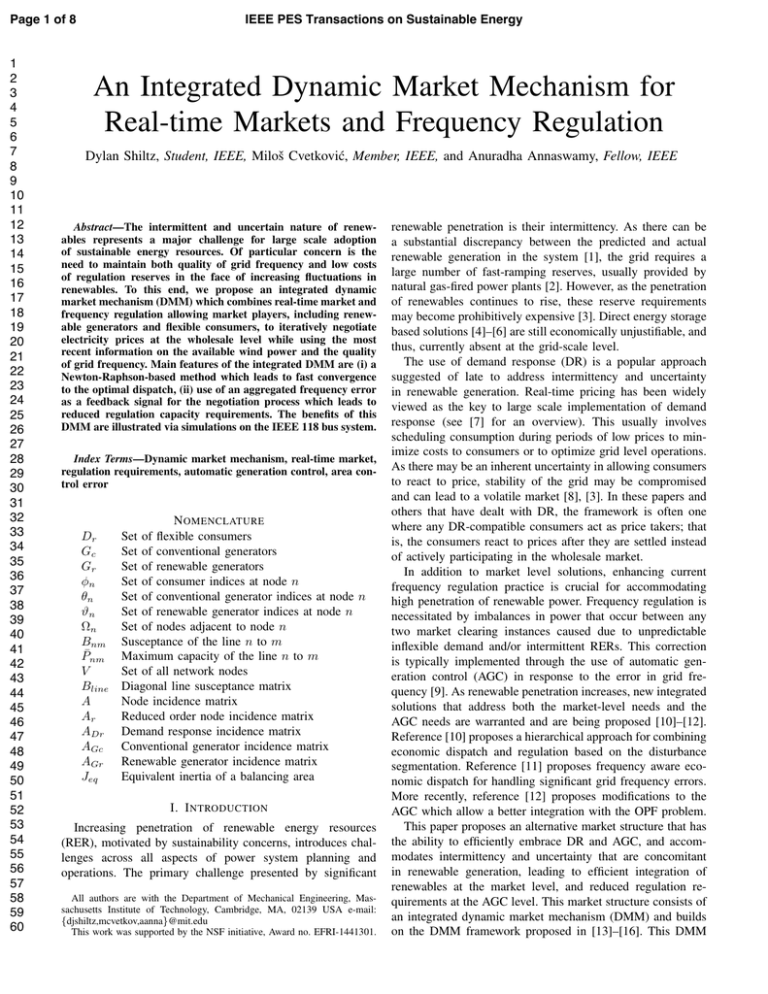
Page 1 of 8
1
2
3
4
5
6
7
8
9
10
11
12
13
14
15
16
17
18
19
20
21
22
23
24
25
26
27
28
29
30
31
32
33
34
35
36
37
38
39
40
41
42
43
44
45
46
47
48
49
50
51
52
53
54
55
56
57
58
59
60
IEEE PES Transactions on Sustainable Energy
An Integrated Dynamic Market Mechanism for
Real-time Markets and Frequency Regulation
Dylan Shiltz, Student, IEEE, Miloš Cvetković, Member, IEEE, and Anuradha Annaswamy, Fellow, IEEE
Abstract—The intermittent and uncertain nature of renewables represents a major challenge for large scale adoption
of sustainable energy resources. Of particular concern is the
need to maintain both quality of grid frequency and low costs
of regulation reserves in the face of increasing fluctuations in
renewables. To this end, we propose an integrated dynamic
market mechanism (DMM) which combines real-time market and
frequency regulation allowing market players, including renewable generators and flexible consumers, to iteratively negotiate
electricity prices at the wholesale level while using the most
recent information on the available wind power and the quality
of grid frequency. Main features of the integrated DMM are (i) a
Newton-Raphson-based method which leads to fast convergence
to the optimal dispatch, (ii) use of an aggregated frequency error
as a feedback signal for the negotiation process which leads to
reduced regulation capacity requirements. The benefits of this
DMM are illustrated via simulations on the IEEE 118 bus system.
Index Terms—Dynamic market mechanism, real-time market,
regulation requirements, automatic generation control, area control error
Dr
Gc
Gr
φn
θn
ϑn
Ωn
Bnm
P̄nm
V
Bline
A
Ar
ADr
AGc
AGr
Jeq
N OMENCLATURE
Set of flexible consumers
Set of conventional generators
Set of renewable generators
Set of consumer indices at node n
Set of conventional generator indices at node n
Set of renewable generator indices at node n
Set of nodes adjacent to node n
Susceptance of the line n to m
Maximum capacity of the line n to m
Set of all network nodes
Diagonal line susceptance matrix
Node incidence matrix
Reduced order node incidence matrix
Demand response incidence matrix
Conventional generator incidence matrix
Renewable generator incidence matrix
Equivalent inertia of a balancing area
I. I NTRODUCTION
Increasing penetration of renewable energy resources
(RER), motivated by sustainability concerns, introduces challenges across all aspects of power system planning and
operations. The primary challenge presented by significant
All authors are with the Department of Mechanical Engineering, Massachusetts Institute of Technology, Cambridge, MA, 02139 USA e-mail:
{djshiltz,mcvetkov,aanna}@mit.edu
This work was supported by the NSF initiative, Award no. EFRI-1441301.
renewable penetration is their intermittency. As there can be
a substantial discrepancy between the predicted and actual
renewable generation in the system [1], the grid requires a
large number of fast-ramping reserves, usually provided by
natural gas-fired power plants [2]. However, as the penetration
of renewables continues to rise, these reserve requirements
may become prohibitively expensive [3]. Direct energy storage
based solutions [4]–[6] are still economically unjustifiable, and
thus, currently absent at the grid-scale level.
The use of demand response (DR) is a popular approach
suggested of late to address intermittency and uncertainty
in renewable generation. Real-time pricing has been widely
viewed as the key to large scale implementation of demand
response (see [7] for an overview). This usually involves
scheduling consumption during periods of low prices to minimize costs to consumers or to optimize grid level operations.
As there may be an inherent uncertainty in allowing consumers
to react to price, stability of the grid may be compromised
and can lead to a volatile market [8], [3]. In these papers and
others that have dealt with DR, the framework is often one
where any DR-compatible consumers act as price takers; that
is, the consumers react to prices after they are settled instead
of actively participating in the wholesale market.
In addition to market level solutions, enhancing current
frequency regulation practice is crucial for accommodating
high penetration of renewable power. Frequency regulation is
necessitated by imbalances in power that occur between any
two market clearing instances caused due to unpredictable
inflexible demand and/or intermittent RERs. This correction
is typically implemented through the use of automatic generation control (AGC) in response to the error in grid frequency [9]. As renewable penetration increases, new integrated
solutions that address both the market-level needs and the
AGC needs are warranted and are being proposed [10]–[12].
Reference [10] proposes a hierarchical approach for combining
economic dispatch and regulation based on the disturbance
segmentation. Reference [11] proposes frequency aware economic dispatch for handling significant grid frequency errors.
More recently, reference [12] proposes modifications to the
AGC which allow a better integration with the OPF problem.
This paper proposes an alternative market structure that has
the ability to efficiently embrace DR and AGC, and accommodates intermittency and uncertainty that are concomitant
in renewable generation, leading to efficient integration of
renewables at the market level, and reduced regulation requirements at the AGC level. This market structure consists of
an integrated dynamic market mechanism (DMM) and builds
on the DMM framework proposed in [13]–[16]. This DMM
IEEE PES Transactions on Sustainable Energy
1
2
3
4
5
6
7
8
9
10
11
12
13
14
15
16
17
18
19
20
21
22
23
24
25
26
27
28
29
30
31
32
33
34
35
36
37
38
39
40
41
42
43
44
45
46
47
48
49
50
51
52
53
54
55
56
57
58
59
60
proposes that DR-compatible consumers act as price setters, by
playing an active role in the electricity market leading towards
financially binding agreement involving quantity and price. It
consists of a distributed decision making process in which
market players and the ISO iteratively exchange information
until an optimal generation/consumption dispatch is reached.
The iterative approach in DMM allows the incorporation of
any real-time information that becomes available about the
intermittent RER, thereby having the potential to generate
higher social welfare when compared to OPF [16]. In [14],
integration with the AGC timescales is explored and conditions
under which the resulting hierarchical transactive structure can
achieve an improved performance is explored.
The DMM proposed in [13]-[16] however suffers from
two major deficiencies: (1) the speed of convergence of the
underlying gradient method imposes significant limitations on
the rate of convergence and therefore the requisite market
clearing period; (2) the impact of the DMM on faster timescales for frequency regulation and AGC is not addressed. In
this paper, we address both of these deficiencies.
We propose an integrated DMM in this paper that combines
market clearing procedure with automatic generation control
and allows for highly efficient and timely operation of power
systems with large penetration of intermittent RER power.
The integrated DMM is derived in two steps. In the first
step, we propose the use of a modified Newton-Raphson
method which ensures significantly faster convergence and
therefore a shorter market clearing period compared to that
of the OPF. Additionally, the proposed method utilizes a
minimum information exchange while sensitive information,
such as generation/consumption bounds and cost/utility curves,
remain private to producers/consumers. In the second step,
we propose the use of an aggregated grid frequency error as
a feedback signal from the frequency regulation layer to the
market layer for improving optimal dispatch. The resulting
integrated DMM is shown to lead to better utilization of
renewables at the market-level and lower regulation capacity
and energy requirements at the AGC level.
In Section II, we outline the DMM algorithm, give conditions for provable convergence and discuss the real-time implementation. In Section III, we describe the integrated DMM
which combines real-time market and frequency regulation in
order to correct market dispatches. In Section IV simulation
results are presented. Section V provides concluding remarks.
II. P ROPOSED E LECTRICITY M ARKET M ODEL
In this section, we present the first step in our integrated
market design, which corresponds to DMM. Following preliminaries that present the overall time scales, the framework for
market clearing is presented in Section II-B. This is followed
by the actual DMM in II-C, its convergence properties in II-D,
wind model in II-E, and implementation in II-F.
Fig. 1. Underlying time-scales in the proposed DMM.
Tℓ = tℓ+1 − tℓ for time-scale ℓ. The periods TK and TM
correspond to the existing time-scales associated with AGC
dispatch and real-time market clearing time (and are typically
2 sec and 5 min, respectively). The periods Tk and Tm are
introduced to define our integrated DMM, where Tk ≪ TK
and TK ≪ Tm ≪ TM , and will be defined more precisely
later. Finally, we define index sets Φm , ΦM , Ψm , and ΨM ,
where Φℓ = {K|tK < tℓ } and Ψℓ = {K|tℓ ≤ tK < tℓ+1 }.
B. Economic Dispatch Framework with Barrier Functions
In order to describe the DMM, we start with market
clearing, the procedure by which economic dispatch is carried
out [16]. Participants in this market are generation companies
(GenCos) that seek to recover their fuel costs, consumer
companies (ConCos) who seek to procure electric energy for
their needs, and ISO who acts on behalf of ConCos and
GenCos, maximizing the utility of ConCos while minimizing
the cost of GenCos. The objective function that ISO uses to
solve this optimization problem is commonly termed Social
Welfare, denoted here by SW and defined as
!
!
!
CGri (PGri )
UDri (PDri ) −
CGci (PGci ) −
SW =
i∈Dr
We denote xi as the value of quantity x at time ti (see
Fig. 1). We then denote four different time-scales, tk , tK , tm ,
and tM , with corresponding periods Tk , TK , Tm , TM , where
i∈Gr
i∈Gc
where quadratic utility curves of flexible consumers and
quadratic cost curves of conventional and renewable generators
are given in (1), (2) and (3), respectively.
cDri 2
P
(1)
UDri (PDri ) = bDri PDri +
2 Dri
cGci 2
CGci (PGci ) = bGci PGci +
P
(2)
2 Gci
cGri 2
CGri (PGri ) = bGri PGri +
P
(3)
2 Gri
Parameters bℓ and cℓ in the above equations reflect base and
incremental cost-utility parameters, respectively, while PDri
is the power demand of flexible consumers and PGci and
PGri is the power supplied by conventional and renewable
generators. The overall market clearing can then be written as
the following optimization problem.
min − SW
subject to
A. Preliminaries
Page 2 of 8
PDcn +
!
i∈φn
+
!
m∈Ωn
PDri −
!
i∈θn
PGci −
(4)
!
PGri
i∈ϑn
Bnm (δn − δm ) = 0 ∀n ∈ V
(5)
Page 3 of 8
1
2
3
4
5
6
7
8
9
10
11
12
13
14
15
16
17
18
19
20
21
22
23
24
25
26
27
28
29
30
31
32
33
34
35
36
37
38
39
40
41
42
43
44
45
46
47
48
49
50
51
52
53
54
55
56
57
58
59
60
IEEE PES Transactions on Sustainable Energy
P Dri ≤ PDri ≤P̄Dri
P Gci ≤ PGci ≤P̄Gci
≤P
≤P̄ˆ
P
∀i ∈ Dr
∀i ∈ Gc
Gri
∀i ∈ Gr
Bnm (δn − δm ) ≤P̄nm
∀n ∈ V,
Gri
Gri
(6)
(7)
(8)
∀m ∈ Ωn
(9)
In this problem, prediction of inflexible power consumption
at node n is denoted by PDcn and δn denotes the voltage
angle at node n. One of the nodes must be designated as
the reference node, at which the voltage angle is defined to be
zero. This is a typical assumption for finding a unique solution
for power flow problems, also known as the slack bus. Since
the true wind generation is not known beforehand, based on
wind predictions, an estimate P̄ˆGri is used in (8).
The optimization problem is then solved to compute soT
T
T T
lution vector x = [δ T PDr
PGc
PGr
] , where all of the
variables comprising vector x are themselves vectors, e.g.
δ = [δ1 , ..., δn ]T . Throughout this paper we assume vector
notation by omitting the corresponding index.
One can accommodate the inequality constraints through
the use of barrier functions [17]. For this purpose, we express
the constraints in (6)–(8) as g1i (x) ≥ 0, i ∈ Dr , Gc , Gr , and
note that these constraints stem from GenCos and ConCos.
We express the constraints in (9) as g2j (x) ≥ 0, j ∈ V , which
stem from the transmission system limitations. We now define
barrier functions β1 (x) and β2 (x) as
! ν
!
ν
, β2 (x) =
(10)
β1 (x) =
g1i (x)
g2j (x)
C. Derivation of DMM
The optimization problem in (4)–(9) is addressed in the
DMM through continued negotiations between generators,
consumers, and ISO, with period Tk and is described below.
For this purpose, Lagrangian (14) of problem (13) could be
solved using a first order gradient interior point method as
in [16]. Due to slow convergence of such methods, we solve
the same optimization problem using a modified version of the
Newton-Raphson method. Second order methods, such as this
one, require fewer iterations to converge, and thus, are more
suitable for time-critical operations.
To apply Newton-Raphson method, we compute the Hessian
and gradient of the Lagrangian as
"
#
Hk N k
∇2 L(xk , λk ) =
(15)
T
Nk
0
"
#
∇x L(xk , λk )
∇L(xk , λk ) =
(16)
h(xk )
where H k = ∇2xx L(xk , λk ) and N k = ∇h(xk ). It follows by
inspection that N k = N , a constant, for all k. To ensure that
the Hessian remains non-singular, the Hessian H k is modified
to H̄ k = H k + cN N T where c is a positive scalar chosen so
that H̄ k is positive definite [17]. This results in a DMM given
by
xk+1 = xk − α · H̄ k ∇x L(xk , λ̂k+1 )
−1
λ
j∈V
i∈Dr ,Gc ,Gr
where ν is a small positive constant used to adjust the slope
of the barrier. Using these barrier functions, which penalize
the solution as it approaches the boundaries of the constraints
in (6)–(9), we construct a modified cost function of the form
f (x) = −SW (x) + β1 (x) + β2 (x).
(11)
Using the modified cost function (11), and denoting (5) as
h(x) = PDc + [AT Bline Ar ADr − AGc − AGr ]x = 0 (12)
the underlying optimization problem becomes
min f (x)
st : h(x) = 0.
(13)
Transmission system parameter matrices A, Ar and Bline
in (12), defined in nomenclature, are a part of a standard
DC power flow representation in matrix form [18]. Parameter
matrices ADr , AGc and AGr are incidence matrices used to
map generation and consumption to their respective nodes.
The Lagrangian of the optimization problem can be expressed as
!
L(x, λ) = f (x) +
λn hn (x)
(14)
n∈V
The typical procedure in the OPF method is to find the optimal
solution x and the corresponding Lagrangian multipliers λn to
determine the optimal dispatch and location marginal price.
In today’s industry, the market clearing procedure is carried
out periodically with period TM (see Fig. 1). In the following
subsection, we propose a dynamic market mechanism which
clears the market with a shorter period Tm .
k+1
= λ̂
k+1
k
− α · c · h(x )
(17)
(18)
where
λ̂k+1 = (N T H̄ k N )−1 (h(xk ) − N T H̄ k ∇f (xk )) (19)
−1
−1
and α is a suitably chosen step size.
D. Convergence of DMM
In this section we will show that iterates (17)–(19) converge
to the unique optimum of problem (13) for a sufficiently small
step size α.
Theorem 1: If H̄ is positive definite and the initial state
x0 is strictly feasible (i.e. g1i (x) > 0, i ∈ Dr , Gc , Gr and
g2j (x) > 0, j ∈ V ), there exists a step size α such that
the DMM iterates (17)–(19) converge to the unique global
optimum of problem (13).
Proof: We prove Theorem 1 using the following two steps:
Step 1: Problem (13) is strictly convex. Step 1 follows
because the equality constraints are affine and the objective
function is strictly convex over the domain of interest, since
the cost curves of the GenCo’s are strictly convex, the utility
curves of ConCo’s are strictly concave, and the barrier functions are strictly convex for g(x) > 0. This also implies that
KKT conditions [17] are sufficient for global optimality. !
Step 2: There exists a step size α such that the sequence
xk converges to a stationary point of L(x, λ). Step 2 can be
proved as follows. We rewrite the iterates from (17) as
xk+1 = xk − α · H̄ k ∇x Lc (xk , λk+1 )
−1
(20)
where Lc is the Lagrangian of the problem of minimizing
f (x) + 2c ||h(x)||2 subject to h(x) = 0. For all feasible points
IEEE PES Transactions on Sustainable Energy
(i.e. for all x such that h(x) = 0), these are identical problems,
and so their minima coincide. Next we require that ∇Lc is
Lipschitz continuous, or that
∥∇Lc (u) − ∇Lc (v)∥ ≤ L∥u − v∥,
∀u, v ∈ X
(21)
holds for some L > 0, where X = {x|Lc (x) ≤ Lc (x0 )}.
Since Lc is twice continuously differentiable on X , condition (21) holds for some L > 0. From (20) we define a
direction dk = −(H̄ k )−1 ∇Lc which is a descent direction
of Lc when H̄ k is positive definite. Thus, for a sufficiently
small step size α, xk remains in the set X for every k.
As noted in [17], if the Lipschitz condition (21) holds, and
if α is chosen such that
0<α<
2|∇Lc (xk , λk+1 )dk |
L∥dk ∥2
(22)
K
wm
ˆ
w̄
ˆM
w̄
1.12
Percent of Nominal Wind Power
1
2
3
4
5
6
7
8
9
10
11
12
13
14
15
16
17
18
19
20
21
22
23
24
25
26
27
28
29
30
31
32
33
34
35
36
37
38
39
40
41
42
43
44
45
46
47
48
49
50
51
52
53
54
55
56
57
58
59
60
Page 4 of 8
1.1
1.08
1.06
1.04
1.02
1
0.98
0.96
0.94
0
500
1000
1500
Time [s]
Fig. 2. True wind generation, along with sample DMM and OPF predictions.
then every limit point of xk is a stationary point of Lc . Since
a stationary point of Lc corresponds with a stationary point of
L, Step 2 holds.
!
From Step 2, the DMM converges to a stationary point of
L, and so the KKT conditions are met at this point. As argued
in Step 1, KKT conditions are sufficient for global optimality,
thus proving Theorem 1. Furthermore, since N is full rank, the
gradients of the equality constraints are linearly independent,
and so all feasible points are regular. This implies that the KKT
conditions are also necessary and that the optimal Lagrange
multipliers (LMPs) are unique.
"
ˆ m P ′ Gri where w̄
ˆ m is the
We then determine P̄ˆGri in (8) as w̄
K
average of ŵ over K ∈ Ψm .
A similar wind prediction model can also be utilized in
the OPF-method, where the estimate of r̂K is updated at the
corresponding time-scale TM . That is, one can choose
%
rK
K ∈ ΦM
K
r̂OP
=
F
N (µ, σ 2 ) K ∈ ΨM
E. Wind Model and Prediction
F. Distributed Implementation of DMM
To simulate wind generation, we utilize the model from [19]
and generate a non-dimensional random process wK as wK =
H(s, θ)rK where H(s, θ) is a rational transfer function of
order n and unity DC gain, θ is a vector of parameters, and
each element of rK is a Gaussian random variable N (µ, σ 2 ).
To normalize wK , we use µ = 1 and σ = 1/3 (see Fig. 2). The
actual power produced by a wind generator is then calculated
K
using wK as PGr
= wK P ′ Gri , where PGr is a nominal
i ,true
value of the wind power. For simplicity, we assume that the
same wind profile is brought to all wind generators in the
system, which can occur in concentrated wind farms [20].
Since the true wind generation is not known during market
clearing, the upper bound P̄ˆGri from (8) must be estimated
using wind prediction. Increasing penetration of wind generation has made accurate wind predictions essential to power
systems operation (see [21] for a detailed overview). For short
term operations, a range of statistical models have been applied
to wind forecasting, including auto-regressive moving average
(ARMA) models, among others [22].
We assume in this paper that P̂Gri ,true can be estimated as
ŵK P ′ Gri , where ŵK = H(s, θ̂)r̂K and θ̂ is an estimate of
$ To compute r̂K , we assume that
θ with a parameter error θ.
wind conditions in the past are perfectly known, but that there
is a stochastic error introduced when trying to predict future
wind conditions. That is, we set
%
rK
K ∈ Φm−1
K
r̂DM
=
M
N (µ, σ 2 ) K ∈ Ψm−1 ∪ Ψm
We now discuss how the DMM in (17) and (18) can be
implemented by the market players which includes the ISO,
GenCos, and ConCos in a distributed manner. Each iteration
of DMM requires the full update of the gradient of Lagrangian
from (16) with respect to x which consists of following terms
ˆ M P ′ Gri , where w̄
ˆ M is the average
and choose P̄ˆGri as w̄
K
of ŵ over K ∈ ΨM . Fig. 2 shows an example of these
prediction techniques for 25 minutes of wind power.
∇x L(xk , λ̂k+1 ) =∇x (−SW (xk )) + ∇x (β1 (xk ))
+ ∇x (β2 (xk )) + N λ̂k+1 .
(23)
The key feature of (23) which allows distributed implementation is that each market player can evaluate corresponding
terms of this equation using only its own state and its negotiated price at every iteration k. To show this, we analyze each
of the terms in (23) individually.
First, ∇x (−SW (xk )) is composed of cost-utility curves
which belong to generators and consumers as
⎡
⎤
0
⎢ −bDr − cDr P k ⎥
Dr ⎥ .
∇x (−SW (xk )) = ⎢
(24)
k
⎣ bGc + cGc PGc
⎦
k
bGr + cGr PGr
Second, ∇x (β1 (xk )) is composed of barrier functions used
to incorporate limits of generation and demand as
⎡
⎤
0
⎢ ∇PDr (β1 (xk )) ⎥
⎥
∇x (β1 (xk )) = ⎢
(25)
⎣ ∇PGc (β1 (xk )) ⎦ .
k
∇PGr (β1 (x ))
Page 5 of 8
1
2
3
4
5
6
7
8
9
10
11
12
13
14
15
16
17
18
19
20
21
22
23
24
25
26
27
28
29
30
31
32
33
34
35
36
37
38
39
40
41
42
43
44
45
46
47
48
49
50
51
52
53
54
55
56
57
58
59
60
IEEE PES Transactions on Sustainable Energy
where
∇Pℓ (β1 ) =
ν
ν
−
(Pℓk − P̄ℓ )2
(Pℓk − P ℓ )2
(26)
for ℓ ∈ Dr , Gc , Gr . Each row in (24) and (25) is evaluated by
a corresponding generator or consumer.
Third, ∇x (β2 (xk )) is composed of barrier functions used
to incorporate transmission system constraints as
,
-T
∇x (β2 (xk )) = ∇δ (β2 (xk )) 0 0 0
(27)
where
∇δn (β2 (xk )) =
!
m∈Ωn
−
νBnm
(Bnm (δn (k) − δm (k)) − P̄nm )2
νBnm
.
(Bnm (δn (k) − δm (k)) + P̄nm )2
(28)
The gradient in (27) is entirely evaluated by the ISO.
In order to move negotiation forward, generators and consumers must provide the gradient of their cost-utility curve
including the barrier functions ∇x (−SW (xk ) + β1 (xk )) for
the current negotiation xk . This represents the marginal cost
of production (or marginal value of utility) for each entity
at the current negotiation. The ISO evaluates ∇x (β2 (xk )) for
the current negotiation xk , based on the grid topology (i.e. the
layout of transmission lines and the susceptances and power
limits of these lines).
Additionally, each iteration of DMM requires the updated
Hessian
H k = ∇2xx L(xk , λk )
= −∇2xx SW (xk ) + ∇2xx β1 (xk , T ) + ∇2xx β2 (xk ).
(29)
Values of ∇2xx (β1 ) and ∇2xx (β2 ), which are needed to evaluate
the Hessian, contain information about the barriers on generation and consumption which might be considered private. To
compute the true Hessian H k , ∇2xx (β1 ) and ∇2xx (β2 ) needs
to be available to the ISO at every iteration. To avoid this, the
Hessian is approximated as Ĥ in the following way
⎡
⎤
0
0
0
0
⎢ 0 −cDr
0
0 ⎥
⎥ . (30)
Ĥ ≈ −∇2xx SW (xk ) = ⎢
⎣ 0
0
cGc
0 ⎦
0
0
0 cGr
This approximation is of high accuracy when DMM states are
away from the barriers, since ∇2xx (β1 ) ≈ 0 and ∇2xx (β2 ) ≈ 0.
To avoid sharing incremental cost-utility coefficients cℓ , we
propose that the ISO use estimates for the values in Ĥ, which
could be a modification of the ones from the day ahead
market clearing, or obtained by inference based on the type
of generator or consumer. Regardless of the approach taken
to obtain these coefficients, it is important to note that the
equilibrium of the DMM will not be affected, but the paths
that the state variables take (and hence the convergence time)
will be altered.
Finally, it can be proven that the DMM converges to the
global optimum of (13) for a sufficiently small step size α
by replacing H k by Ĥ and following an identical series of
arguments as the proof of Theorem 1. We now require that
ˆ positive definite.
c is chosen sufficiently large to make H̄
In addition to the privacy benefit, we note that unlike H k ,
the approximation Ĥ remains constant for all iterations k.
Therefore, a single offline inversion of Ĥ is sufficient to
implement the proposed market clearing mechanism, greatly
reducing computational requirements.
G. Accommodating Wind Intermittency
Constraints enforced by barrier functions (6)–(8) tend to
change from one market period to the next, due to changes in
wind forecast, operating conditions and energy consumption
throughout the day. To smoothly accommodate this change, we
add another feature to the DMM to dynamically shift barrier
functions in response to a change in inequality constraints.
Moving the barrier functions in a single iteration may cause
g1 (xk ) to become negative, but the barrier functions are only
properly defined for g1 (xk ) > 0. To avoid this scenario, the
barrier functions are moved incrementally by an amount no
larger than a fraction γ ∈ (0, 1) of the distance between current
and desired position of the barrier. The algorithm for shifting
an upper barrier P̄ℓ and a lower barrier P ℓ for a power variable
Pℓ ∈ PDr , PGc , PGr can be written as
P̄ℓk+1 = P̄ℓk − min(γ(P̄ℓk − Pℓk ), P̄ℓk − P̄ℓm )
(31)
P k+1
ℓ
(32)
=
P kℓ
+
min(γ(Pℓk
−
P kℓ ), P m
ℓ
−
P kℓ )
where P̄ℓk and P kℓ
and P̄ℓm and P m
ℓ
are the barrier locations at iteration k,
are the desired barrier locations of the
corresponding market player for period Tm . In the case of
wind generators, we set P̄ℓm = P̄ˆGr .
H. Clearing Intervals
All negotiations occur at time instants tk , whose period Tk
is assumed to be such that enough iterations can occur in a
market period Tm . The assumption is that negotiations that
occur between tm−1 and tm converge well before tm and
the resulting dispatch is used for operations during the period
[tm , tm+1 ]. In other words, during the negotiation phase, each
negotiation xk is only a potential dispatch, and is not financially binding until t = tm . The true demand and generation
K
K
are assumed to be PDc
= PDcn , ∀K, PDr
=
n ,true
i ,true
∗
m
K
∗
m
(PDri ) , K ∈ Ψm , and PGci ,true = (PGci ) , K ∈ Ψm ,
∗
∗
where (PDr
)m and (PGc
)m are the optimal values to which
i
i
the DMM converges for market period Tm .
III. I NTEGRATION WITH AGC
In this section, we address the second step of the proposed
integrated DMM, which pertains to AGC. The purpose of
AGC, as mentioned in the introduction, is to deal with fluctuations in load and generation that occur at a faster timescale and cannot be anticipated at the market time-scales. The
typical procedure in AGC is to use grid frequency deviations
from the nominal (60 Hz in the US) as an indicator of error
in generation. Generator set points are then adjusted with a
period TK (typically 2 sec) based on the error in frequency,
which are at a much faster time-scale than those of market
clearing in a real-time market, which occurs with a period
TM . In addition to the existing implementation of AGC, we
IEEE PES Transactions on Sustainable Energy
1
2
3
4
5
6
7
8
9
10
11
12
13
14
15
16
17
18
19
20
21
22
23
24
25
26
27
28
29
30
31
32
33
34
35
36
37
38
39
40
41
42
43
44
45
46
47
48
49
50
51
52
53
54
55
56
57
58
59
60
propose a feedback algorithm for using a suitable aggregation
of the error in system frequency over a period Tm of DMM as
a correction to the power balance constraint. This is discussed
in more detail below.
Page 6 of 8
detailed structure through the following procedure. Frequency
error is aggregated over the period of a single DMM market
clearing Tm as
!
1
ωK .
(40)
ωm =
|Ψm |
K∈Ψm
A. AGC Modeling
For simplicity, we consider a single frequency balancing
area and assume no tie lines. A simple area-level discrete time
model for AGC can be written as
TK K
K
ω K+1 =ω K +
(P
− PD
− KR (ω K − ωref )) (33)
tot
Jeq Gtot
where
!
PGKtot =
K
PGc
+
i ,true
i∈Gc
K
PD
=
tot
!
!
K
PGr
i ,true
(34)
i∈Gr
K
PDc
+
n ,true
n∈N
!
K
PDr
i ,true
(35)
i∈Dr
and KR is the control gain for the AGC system, chosen
such that the resulting closed loop, discrete time system is
stable, and it is assumed that ω 0 = ωref . The true wind
K
generation, PGr
is due to the wind conditions at time
i ,true
tK . In this paper, we assume that all conventional generators
that are dispatched in the real-time market participate in
providing regulation services by supplying an incremental
quantity of power PRKi in response to the frequency error at
each market clearing instance tK . The amount of incremental
power supplied by each regulation unit is proportional to its
frequency bias factor (denoted by Bi , i ∈ Gc ) and is equal to
PRKi
Bi K
(ω − ωref )
= −KR
Beq
(36)
.
where Beq =
i∈Gc Bi . The total power produced by all
regulation units, referred to as area control error (ACE) is
!
(ACE)K =
PRi K = −KR (ω K − ωref ).
(37)
i∈Gc
We introduce two performance measures to quantify the
behavior of the proposed integrated DMM at the AGC timescale: regulation capacity requirement, CREG , and the total
energy supplied by AGC, EREG . The regulation capacity
requirement is the difference between the highest and lowest
value of ACE over all K and is defined as
CREG = max (ACE)K − min (ACE)K
K∈τ
K∈τ
m
with the resulting ω is fed back into the DMM in the
form of a modified power balance h′ (x) = 0 that replaces
h(x) = 0, defined below. We note that all DMM negotiations
at tk ∈ [tm−1 , tm ] use information obtained over the previous
period Tm−1 , and hence the aggregated frequency information available at tm−1 corresponds to ω m−2 . We define the
modified power balance constraint as
KL KR
AGc B̄(ω m−2 − ωref )
(41)
Beq
.
where B̄ is a vector of elements B̄n = i∈θn Bi , ∀n ∈ V
and KL is a feedback gain chosen by design. Intuitively, the
role of vector B̄ is to disaggregate frequency error and to
distribute it to the nodes with generators who committed to
provide regulation. Such implementation allows the aggregated
frequency error to be met optimally by the market.
Finally, the integrated DMM consists of solving (13) with
the equality constraint replaced by h′ (x) = 0. The iterates of
the integrated DMM at the time scale tk take the form
h′ (xk ) = h(xk ) −
ˆ −1 ∇ L(xk , λ̂k+1 )
xk+1 = xk − α · H̄
x
λ
k+1
λ̂k+1
k+1
′
k
− α · c · h (x )
ˆ −1 N )−1 (h′ (xk ) − N T H̄
ˆ −1 ∇f (xk )).
= (N T H̄
= λ̂
(42)
(43)
(44)
Eqs. (42)-(44) together with the AGC iterates (33) and AGC
aggregation defined by (40) constitute the new integrated
DMM proposed in this paper.
IV. DMM S IMULATION
In this section we validate the integrated DMM described
above using a modified 118 bus test case that includes wind
generation and flexible consumption. The performance of the
integrated DMM is evaluated both with and without feedback
from AGC, and both performances are compared to that
using an OPF. Comparison metrics include eREG and rREG
(introduced in Section IV-B) at the AGC level, and the effect
of underestimation of the wind at the market level.
(38)
where τ is the set of all K for the entire simulation. The
total energy requirement (including both positive and negative
components) is defined as
!/
/
/(ACE)K /.
EREG =
(39)
K∈τ
B. Feedback from AGC to DMM
To integrate AGC and DMM layers, any non-zero average
grid frequency error that may be present is propagated from the
AGC layer to the DMM layer by the means of a hierarchical
feedback control loop. In this paper, we build on the feedback
implementation from [14] by giving it additional and more
A. IEEE 118 Bus Grid
All simulations were performed on a modified IEEE 118 bus
network [23]. While the grid topology, base demand at each
bus, and generator data were left unchanged from the original
test files, flexible consumers and renewable generators were
added according to Tables I and II. When flexible consumer i
is added at a bus, the base demand at that bus was decreased
by P̄Dri , with 10% of the total demand chosen to be flexible.
The base and incremental costs of flexible consumers are
bDri = 40 and cDri = −0.3 ∀i. For simplicity, we assume
that demand adheres to its dispatch from the market clearing.
The total nominal capacity P ′ Gr of all wind generators is
chosen as 30% of total generation in the grid and scattered
TABLE I
A DDITION OF F LEXIBLE C ONSUMERS TO 118 B US G RID
15
45
27
35.5
42
48
49
43.5
54
56.5
62
50
80
50
90
50
116
50
TABLE II
A DDITION OF R ENEWABLE G ENERATORS TO 118 B US G RID
Bus
P ′ Gri
10
170
12
150
25
145
26
230
31
150
46
200
49
190
54
290
59
200
throughout at buses that already contain conventional generation. The base and incremental costs of renewable generators
are bGri = 1 and cGri = 0.1 ∀i. The frequency bias Bi was
set to 1 for all i. We also enforce power flow limits of 300
MW on all transmission lines so that some of the lines are
congested.
It is assumed that the DMM negotiation time-scale is Tk =
4 ms. This enables 7500 iterations for each market clearing
period and was observed to be sufficient for convergence in our
tests on the 118 bus test network. An initial set of negotiations
was assumed to occur so that we begin with an appropriate
initial dispatch at T0 . We use α = 0.001, ν = 1 and c = 1 in
all simulations, and select our initial state variables halfway
between their corresponding barrier functions; if a variable has
no barrier functions, we assume it starts at zero.
300
PGc
PGr
PDr
Generation [MW]
Bus
P Dri
2500
2000
1500
0
250
500
1000
Fig. 3. Time-profile of 50 market clearings using the DMM. The iterations
between any two market clearings are not shown.
50
0
−50
−100
−150
−200
DMM (no feedback)
DMM (feedback)
OPF
−250
B. Test Cases
We run three sets of test cases, based on the parameter error
in wind prediction defined in Section II-E, with (1) θ$ = 0, (2)
θ$ = +5%, and (3) θ$ = −5% respectively. In each case, for
a given gain KL , we run the DMM for 50 market clearings
over a 25 minute window, for 20 different realizations of wind
power w. Each of these 1000 runs is then repeated for five
different gain values KL ∈ {0, 0.2, 0.4, 0.6, 0.8}. Finally, over
the same 25 minute window, the OPF market model is run for
20 realizations of wind power. To compare DMM and OPF we
DM M
OP F
define relative performance measures cREG = CREG
/CREG
DM M
OP F
and eREG = EREG /EREG .
C. Simulation Results and Discussion
We now outline the main results of the market simulations.
We start by illustrating the ability of the DMM to rapidly
schedule conventional generators and flexible consumers in
response to wind predictions at the market level, which is
shown in Fig. 3, through the total PGc,true , PGr,true , and
PDr,true (denoted as PGc , PGr , and PDr ) over a 25 minute
period. It is seen that during periods of low wind generation,
the DMM dispatches include higher conventional generation
and lower flexible consumption. Also, during periods of high
wind generation, conventional generation is lowered and flexible consumption is increased. It was also observed in this
case that the DMM resulted in a more efficient utilization of
the available wind in comparison with the OPF by virtue of a
better prediction of PGr,true .
Next we illustrate the effects the DMM has on the AGC
system in Fig. 4, where we plot the area control error over the
200
1500
Time [s]
ACE [MW]
1
2
3
4
5
6
7
8
9
10
11
12
13
14
15
16
17
18
19
20
21
22
23
24
25
26
27
28
29
30
31
32
33
34
35
36
37
38
39
40
41
42
43
44
45
46
47
48
49
50
51
52
53
54
55
56
57
58
59
60
IEEE PES Transactions on Sustainable Energy
Flexible Demand [MW]
Page 7 of 8
−300
0
500
1000
1500
Time [s]
Fig. 4. ACE with the DMM and OPF for θ! = −5% over a 25 minute
window.
course of a 25 minute simulation with θ$ = −5%. Qualitatively,
one can observe that the peaks in ACE are less severe for
the DMM simulations than the OPF. Furthermore, we get
additional improvement by adding feedback from the AGC
layer. This simulation included a negative parameter estimation
error, which means that there was a surplus of wind energy in
the grid. The feedback from AGC serves to partially correct
for this surplus, shifting ACE closer to zero.
Finally, we quantify these benefits and investigate the effects
of the feedback gain KL by running the test cases. As seen
in Fig. 5, for all the test cases, eREG < 1 indicating an
improvement over the OPF model. We also see that as the
feedback gain KL is increased from 0 to 0.6, eREG tends to
decrease even further. However, as KL is increased beyond
0.6, eREG actually starts to increase in some cases. This is
because there is a delay between tm−1 , the time at which
the last frequency measurement is taken, and tm , the time
at which the market dispatch is adjusted, and therefore a
corresponding discrepancy in the frequency. If the feedback
gain is too high, these discrepancies are amplified reducing
the benefit of feedback.
From Fig. 6, it is seen that DMM also improves the
regulation capacity requirements, albeit to a lesser degree. This
is likely due to the stochastic nature of our prediction model.
IEEE PES Transactions on Sustainable Energy
Additionally, we obtain these improvements while preserving
the privacy of the market players’ information at the real-time
market. Together, these numbers demonstrate the proposed
integrated DMM can serve as a viable alternative at the
real-time market and AGC time-scales. How these market
mechanisms can be integrated into the existing framework of
planning and operations is a topic for future study.
1
θ! = +5%
θ! = 0%
θ! = −5%
0.9
0.7
e
REG
0.8
0.6
R EFERENCES
0.5
0.4
−0.2
0
0.2
0.4
0.6
0.8
1
KL
Fig. 5. Improvement in energy requirements of AGC with DMM over OPF
as a function of KL .
1.2
REG
1.1
c
1
2
3
4
5
6
7
8
9
10
11
12
13
14
15
16
17
18
19
20
21
22
23
24
25
26
27
28
29
30
31
32
33
34
35
36
37
38
39
40
41
42
43
44
45
46
47
48
49
50
51
52
53
54
55
56
57
58
59
60
Page 8 of 8
θ! = +5%
θ! = 0%
θ! = −5%
1
0.9
0.8
0.7
0.6
−0.2
0
0.2
0.4
0.6
0.8
1
KL
Fig. 6. Improvement in regulation requirements of AGC with DMM over
OPF as a function of KL .
As seen in Fig. 2, during certain market clearings there is a
ˆ m . Although rare,
substantial error in the DMM prediction w̄
the AGC system must be able to handle such occurrences, and
thus cREG is not significantly reduced. We see that cREG is
between 0.8 and 1.0 on average without any feedback gain.
However, as the feedback gain is increased, the regulation
requirement tends to increase on average.
These results suggest that perhaps there is an optimal choice
for KL , large enough to provide improvement for eREG , yet
not so large that it results in a larger capacity requirement. In
future work, we aim to model the regulation market explicitly
and evaluate the reductions in energy and regulation capacity
requirements in terms of a single cost saving.
V. S UMMARY AND C ONCLUDING R EMARKS
In this paper, we have described an integrated DMM which
combines real-time market and frequency regulation to accommodate intermittency of RERs. We have demonstrated via
simulations on the IEEE 188-bus system that (i) a NewtonRaphson-based DMM implementation enables more frequent
economic dispatch than the OPF, on the order of 30 sec rather
than 5 min (ii) use of an aggregate frequency error at the
real-time market reduces regulation capacity requirements by
about 10% and AGC energy requirements by about 25%.
[1] B. Hodge, M. Milligan, Wind Power Forecasting Error Distributions over
Multiple Timescales, IEEE PES General Meeting, 2011.
[2] H. Shun-Hsien, D. Maggio, K. McIntyre, V. Betanabhatla, J. Dumas,
J. Adams, Impact of wind generation on system operations in the deregulated environment: ERCOT experience, IEEE PES General Meeting, 2009.
[3] S. Meyn, M. Negrete-Pincetic, G. Wang, A. Kowli, E. Shafieepoorfard,
The Value of Volatile Resources in Electricity Markets, IEEE Conference
on Decision and Control, 49:4921–4926, 2010.
[4] H. Akhavan-Hejazi, H. Mohsenian-Rad, Optimal Operation of Independent Storage Systems in Energy and Reserve Markets with High Wind
Penetration, IEEE Tran. on Smart Grid, 5(2), 2014.
[5] J. A. Taylor, D. S. Callaway, K. Poolla, Competitive Energy Storage in
the Presence of Renewables, IEEE Tran. on Power Systems, 28(2), 2013.
[6] A. A. Soloman, D. M. Kammen, D. Callaway, The role of large-scale
energy storage design and dispatch in the power grid: A study of very
high grid penetration of variable renewable resources, Applied Energy,
134:75–89, 2014.
[7] Z. Baharlouie, M. Hashemi, H. Narimani, H. Mohsenian-Rad, Achieving
Optimality and Fairness in Autonomous Demand Response: Benchmarks
and Billing Mechanisms, IEEE Tran. on Smart Grid, 4(2), 2013.
[8] M. Roozbehani, M. A. Dahleh, S. K. Mitter, Volatility of Power Grids
under Real-Time Pricing, IEEE Tran. on Power Systems, 27(4), 2012.
[9] P. Kundur, Power System Stability and Control, McGraw-Hill, 1997.
[10] S. Liu, M. Ilic, Hierarchical Power Systems Control, Its Value in a
Changing Industry, Springer, 1996.
[11] A. Thatte, F. Zhang, L. Xie, Frequency Aware Economic Dispatch, North
American Power Symposium, 2011.
[12] N. Li, L. Chen, C. Zhao, Connecting automatic generation control and
economic dispatch from an optimization view, IEEE Tran. Control of
Network Systems, to appear 2015.
[13] A. Kiani, A. M. Annaswamy, Equilibrium in Wholesale Energy Markets:
Perturbation Analysis in the Presence of Renewables, IEEE Tran. on
Smart Grid, 5(1):177–187, January 2014.
[14] A. Kiani, A. M. Annaswamy, T. Samad, A Hierarchical Transactive
Control Architecture for Renewables Integration in Smart Grids: Analytical modeling and stability, IEEE Tran. on Smart Grid, Special Issue on
Control Theory and Technology, 5(4):2054–2065, July 2014.
[15] A. Kiani, A. M. Annaswamy, A Dynamic Mechanism for Wholesale
Energy Market: Stability and Robustness, IEEE Tran. on Smart Grid,
5(6):2877–2888, November 2014
[16] J. Hansen, J. Knudsen, A. M. Annaswamy, A Dynamic Market Mechanism for Integration of Renewables and Demand Response, submitted to
IEEE Tran. on Smart Grid.
[17] D. P. Bertsekas, Nonlinear Programming, Athena Scientific, Belmont,
Massachusetts, 1999.
[18] M. Ilic, J. Zaborszky, Dynamic and Control of Large Electric Power
Systems, John Wiley & Sons, 2000.
[19] A. J. Larsen, T. S. Mogensen, Individuel pitchregulering af vindmølle,
M.S. Thesis, Informatics and Mathematical Modelling, Technical University of Denmark, 2006.
[20] P. E. Sørensen, N. A. Cutululis, A. Vigueras-Rodriguez, L. E. Jensen,
J. Hjerrild, M. H. Donovan, H. Madsen, Power Fluctuations from Large
Wind Farms, IEEE Tran. on Power Systems, 22:958–965, 2007.
[21] D. R. Chandra, M. S. Kumari, M. Sydulu, A Detailed Literature Review
on Wind Forecasting, Int. Conf. on Power, Energy, and Control (ICPEC),
2013.
[22] P. Pinson, Very short-term probabilistic forecasting of wind power with
generalized logit-normal distributions, Journal of the Royal Statistical
Society (Applied Statistics), 61(4):555–576, 2012.
[23] Data source: https:www.ee.washington.eduresearchpstcapf118


